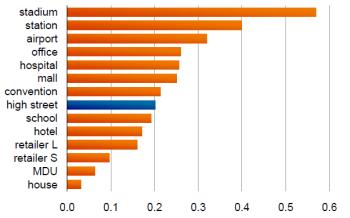 Ever thought about where to site your mobile data connectivity service? I have to admit I’ve not spent much time on it myself. I’d probably come up with a topographical map of where I was providing the service and plan a series of base stations to give me optimum coverage – most bang for my buck. Nothing new really.
Ever thought about where to site your mobile data connectivity service? I have to admit I’ve not spent much time on it myself. I’d probably come up with a topographical map of where I was providing the service and plan a series of base stations to give me optimum coverage – most bang for my buck. Nothing new really.
That’s why the chart on the right makes interesting reading. Provided by Ruckuswireless the graph shows the relative demand density for data usage in Mbps per 10m2 based on type of location. Most of the high demand locations are indoor. The high street, which is where most of us would think of putting in capacity ranks 8th.
Ok the stats come from